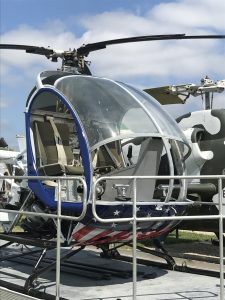The Hughes TH-55 Osage was a pist on-powered light training helicopter produced for the United States Army. It was also produced as the Model 269 family of light utility helicopters, some of which were marketed as the Model 300. The Model 300C was produced and further developed by Schweizer after 1983.
on-powered light training helicopter produced for the United States Army. It was also produced as the Model 269 family of light utility helicopters, some of which were marketed as the Model 300. The Model 300C was produced and further developed by Schweizer after 1983.
In 1955, Hughes Tool Company’s Aircraft Divison carried out a market survey which showed that there was a demand for a low-cost, lightweight two-seat helicopter. The division began building the Model 269 in September 1955. It was initially designed as a fully glazed cockpit with seating for two pilots, or a pilot and passenger. It also had an open-framework fuselage and a three-blade articulated rotor. The prototype flew on October 2, 1956 but it wasn’t until 1960 that the decision was made to develop the helicopter for production. The original truss-work tailboom was replaced with a tubular tailboom and the cockpit was restructured and refined prior to being put into production. With this model Hughes successfully captured a large portion of the civilian helicopter market with an aircraft that would prove itself popular in agriculture, police work and other duties.
The Hughes 269 was created with a fully articulated clockwise-rotating (as seen from the cockpit), three-bladed main rotor, and a two-bladed tail rotor that would remain as distinctive characteristics of all its variants. It also has shock absorber-damped, skid-type landing gear. The flight controls are directly linked to the control surfaces of the helicopter so there are no hydraulic systems in the 269. There are generally two sets of controls, although this was optional on the civil 269A. For three-seat aircraft, the middle collective control stick is removable and a seat cushion can be put in its place for the third passenger.
In 1958, prior to full-time production, Hughes provided five pre-production Model 269 examples to the U.S. Army for evaluation as a light observation helicopter to replace the aging OH-13 Sioux and OH-23 Raven. Designated as the YHO-2HU the helicopter was eventually turned down. April 9 ,1959 the 269 received certification from the FAA and Hughes continued to concentrate on civil production. With some design changes, deliveries of the Model 269A version began in 1961. By mid-1963 about 20 aircraft were being produced a month and by the spring of 1964, 314 had been built.
While the Army hadn’t found the Model 269 adequate for combat missions, in 1964 it adopted the Model 269A as its training helicopter to replace the TH-23 and designated it the TH-55A Osage. 792 TH-55 helicopters would be delivered by 1969, and it would remain in service as the Army’s primary helicopter trainer until it was replaced in 1988 by the UH-1 Huey. At the time of its replacement, over 60,000 Army pilots had trained on TH-55 making it the Army’s longest serving training helicopter. In addition to the US Army, Hughes delivered TH-55/269/300s to other military customers.
In 1964, Hughes introduced the slightly larger three-seat Model 269B which it marketed as the Hughes 300. The Hughes 300 was followed in 1969 by the improved Hughes 300C (sometimes 269C), which first flew on March 6, 1969 received FAA certification in May 1970. In 1986, Schweizer acquired all rights to the helicopter from McDonnell Douglas, who had purchased Hughes Helicopters in 1984 and renamed it McDonnell Douglas Helicopter Systems. Between Hughes and Schweizer, and including foreign-licensed production civil and military training aircraft, nearly 3,000 copies of the Model 269/300 have been built and flown over the last 50 years.
Interactive Display
Click on a colored PIN to display additional information (text, video, recording, images).
This feature is an extra benefit as you walk around the display in our Airpark.
WIFI is provided for your mobile device. A network QR code or name/password is provided at the desk.
PINS
PINS
PINS
PINS
